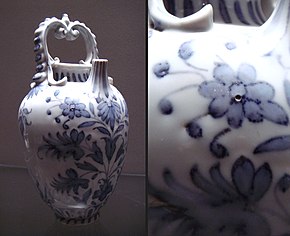
Medici porcelain was the first successful attempt in Europe to make imitations of Chinese porcelain, though it was soft-paste porcelain rather than the hard-paste made in Asia. The experimental manufactory housed in the Casino of San Marco in Florence existed between 1575 and 1587 under the patronage of Francesco I de' Medici, Grand Duke of Tuscany. Surviving examples are extremely rare, numbering 59 according to the Metropolitan Museum of Art.[1]
A painted mark of Brunelleschi's dome and a capital letter F appear on the underside of some pieces; others bear the Medici palle, the balls that are the Medici heraldic charge. Never a commercial venture, Medici porcelains were sometimes given as diplomatic gifts; for example, surviving pieces bear the arms of Philip II of Spain.
In 1995, a vase dated to around 1575, was sold in Paris for FRF6,430,000 (at the time equivalent to £870,000).[2] In 1999, a cruet dated circa 1575 was auctioned at Christie's for £287,000.[3]
- ^ "Medici Porcelain Manufactory | Dish | Italian, Florence". The Metropolitan Museum of Art. Retrieved 10 March 2023.
- ^ "Pounds 870,000 Medici vase is a rare bargain". Independent.co.uk. 10 December 1995.
- ^ A MEDICI PORCELAIN CRUET, WITH SILVER-GILT AND GILT-METAL MOUNTS